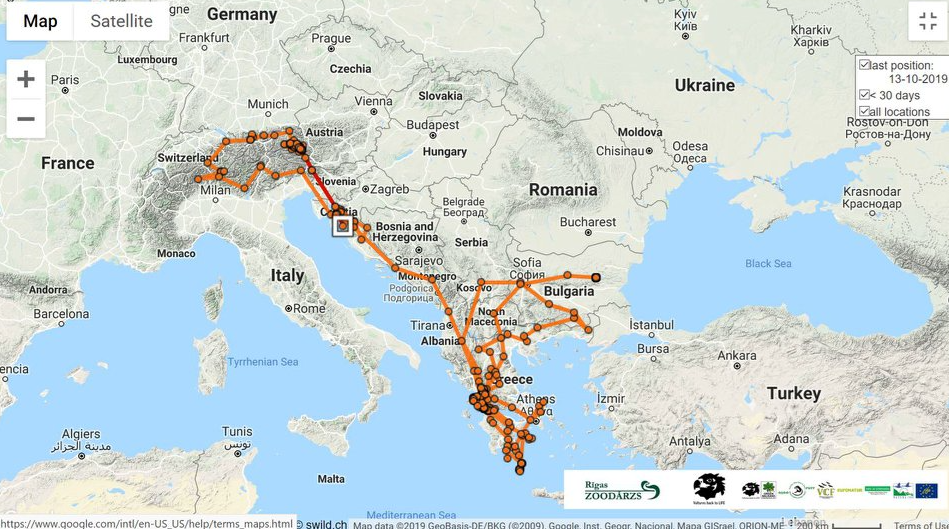
After spending the summer in the Austrian Alps, the Cinereous Vulture Riga is heading south to the Balkans to find warmer wintering grounds. Riga is the third of the Cinereous Vultures reintroduced into Bulgaria as part the first stage of the Vultures Back to LIFE conservation project. After its release, the Riga had many adventures in the Balkans and beyond, setting some impressive records. It was the first Cinereous Vulture to visit Croatia after 70 years of absence and the second to visit Albania in decades! Now, the bird continues its many travels.
Riga heading to the Balkans
After spending the summer of 2019 in the Alps, mainly in Austria, Riga headed south towards warmer wintering grounds. The bird crossed Slovenia, Croatia, Bosnia and Herzegovina, and is currently in Serbia.
We are looking forward to seeing if Riga decides to go back to its Bulgarian home where it was released. You can follow the movements of the bird on our online public maps.

Update 20/10/19
Riga returned to Bulgaria! Now we have to wait and see is the bird will visit the release site. In the last month, the vulture travelled over 2000km.
Update 21/10/19
On Monday 21 October, Riga was sighted and photographed by Hristo Peshev at the Kresna Gorge!

Where are the other reintroduced vultures?
The Vultures Back to LIFE project started to reintroduce birds into the wild last year, to bring the species back to Bulgaria for the first time in decades! Where are the reintroduced birds now?
Boyan (also released 2018) was the first to leave the Balkan Peninsula, travelling to Turkey where he remains. He is currently in the north of Ankara.
The birds released this year are staying in the East Balkan Mountain, in the Kotel – Sliven area.
The importance of monitoring vulture movements
In their first few years, young Cinereous Vultures travel extensively, and these birds are no exception. The travels of these birds across countries illustrates that vultures know no borders and their successful conservation depends on the mutual actions of all countries across the region to tackle the threats they may face such as illegal wildlife poisoning. Through our Balkan Anti-Poisoning Project, we are working across the region collaborating with wildlife organisations and governmental agencies from six different countries to work together to protect vultures.
Cinereous Vultures in the Balkans

The last remaining population of the Cinereous Vultures in the Balkan Peninsula is in the Dadia-Lefkimi-Soufli Forest National Park in the eastern Rhodope Mountains in Greece with a population of around 30-35 pairs breeding pairs. In 2018, our Vulture Back to LIFE vulture conservation project began efforts to create a second colony in the region with the reintroduction of the species to Bulgaria where it has been extinct as a breeding species since 1993. This historic project began in 2018 with the release of three captive-bred birds followed by the release of 10 wild born birds from Spain and 4 more birds from the captive breeding programme in 2019.
Vultures Back to LIFE

Led by the wildlife conservation charity Green Balkans, with activities also implemented by the Fund for Wild Flora and Fauna, and bringing together partners from Bulgaria, Spain and Germany, Vultures Back to LIFE aims to reintroduce the cinereous or Eurasian black vulture to Bulgaria. The team will transfer and release around 60 birds, some from captive-breeding, but mostly coming from wildlife rehabilitation centers in Extremadura (Spain) into the wild in Bulgaria as well as creating supplementary feeding stations and improving populations of wild herbivores, improving the nesting conditions and creating artificial nest sites and tackling some of the major threats to vultures in the country such as insulating electricity pylons and illegal use of poison in the nature.







